This article was written by Brad Korb from LA Homes. Click here for the full article.
A home should be a safe and comfortable retreat for every member of the household — and that includes any four-legged ones that share this space as well. Many people in Los Angeles County have pets, so we figured this would be a great resource to create. Pet owners have the added responsibility of making sure their pets can have a safe environment at home, and this is particularly true for those with puppies and kittens who are naturally inquisitive.
This guide will look at each room of the home, as well as outside yards. It will review potential problem areas and how owners can better “pet-proof” each. This complete guide will help pet owners determine which indoor and outdoor plants are toxic, why appliance and window cords can be hazardous to pets and how to go about making renovations to make a home even more pet-friendly.
Enjoy the peace of mind of making — and keeping — your home safe for your cat or dog.
Pet Safety in the Bedroom
Drawers

Open drawers can be an almost irresistible temptation for puppies and kittens. Care should be taken to keep drawers closed to prevent accidentally trapping a small pet. If you discover an open drawer, check inside before closing. Open drawers can also serve as a ladder for cats to climb to even higher, potentially unsafe heights.
When upper drawers are left open, they can create a tipping issue for larger dogs or cats. Open drawers also provide an invitation for pets to chew on socks, undergarments, and other clothing. There may be other items stored in drawers that contain buttons or other potential choking hazards.
The simple solution is to keep drawers closed.
Closets
Like drawers, closets are a very attractive place for pets, especially small ones, to hide and explore. Closets usually contain a lot of items that can cause safety concerns. Shoes, for example, have laces that can have plastic ends that can be chewed off. Clothing or boxes may fall from shelves causing injury or trapping a small pet.
Mothballs can be more toxic to cats than dogs but dogs are more likely to ingest them. Naphthalene mothballs can cause a variety of ailments in pets when ingested including vomiting, anaemia and even liver or kidney problems.
Pet owners often find it easier to keep closet doors closed when not at home and check closets before potentially trapping a pet inside.
Laundry
Beyond the potential damage a pet may cause to clothing left on the floor or in a laundry basket, laundry also poses some safety risks to pets. Pets can chew off or choke on buttons or drawstrings. Elastic stitching in undergarments and socks can also choke a pet.
It can be best to keep laundry in a closed clothes hamper or in a closet with the doors closed until laundry day.
Pet Safety in the Bathroom
Medication
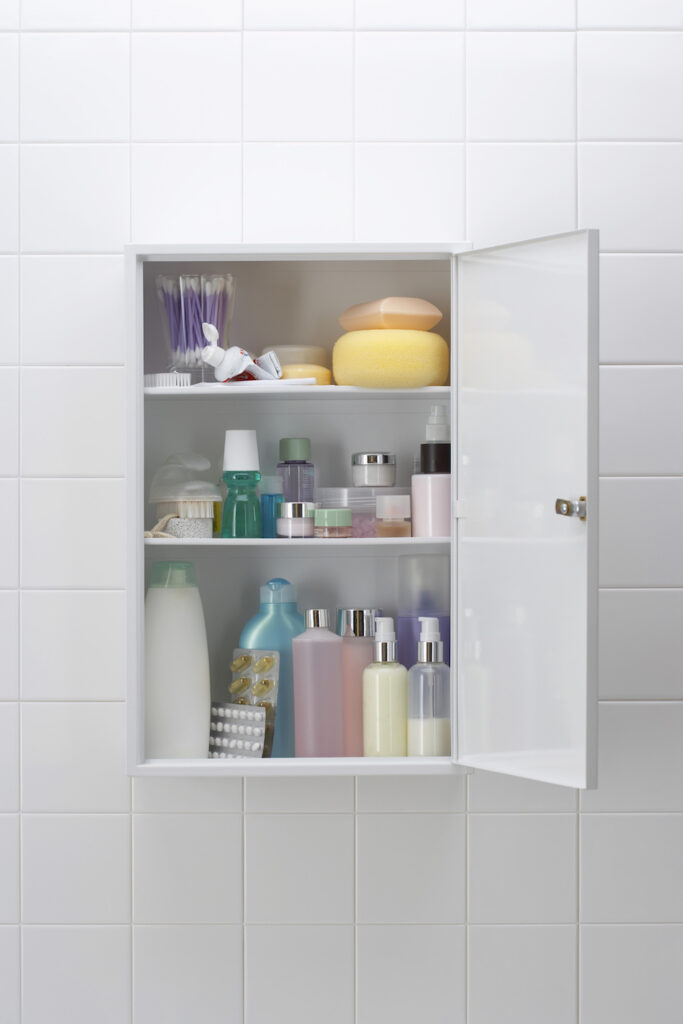
If medications are stored properly up in a medicine cabinet, they are of little risk to pets. Problems arise, however, if medications are left on sinks and countertops and lids are left open. Some human medications can be fatal if ingested by pets, including some over-the-counter drugs. Care should also be taken to keep pet medication and human medications stored safely apart from each other, limiting potential mix-ups. No human medication should ever be given to a pet without the approval of a veterinarian. If a pet is lethargic, is vomiting or is having trouble breathing and you suspect medications to be the problem, you should contact your veterinarian and the ASPCA Animal Poison Control Center’s 24-hour phone number at 888-426-4435 or the Poison Control Center at 800-222-1222.
Toothpaste and Cosmetics
Human toothpaste offers some dangers for dogs, in particular when they contain xylitol, a sweetener often used in the product. When dogs ingest toothpaste that contains xylitol, it can lead to vomiting, seizures and in some severe instances, liver damage. Adding to the danger is the fact that most toothpaste is packaged in soft, squeezable tubes that are inviting to pets and can be easily punctured by a dog or a cat’s teeth.
Many common cosmetics contain ingredients that can be poisonous to pets including tea tree oil, minoxidil, toluene, formaldehyde, acetone and more. Hand sanitisers have large amounts of isopropyl alcohol which is dangerous to pets. Even common deodorants contain aluminium which can be harmful when ingested by small animals.
These products should be safely stored away in a cabinet or container. Care should be taken to make sure a cabinet door can’t be sprung open by pawing from a pet. If it can be potentially opened by a pet, consider the use of childproof door locks.
Toilets
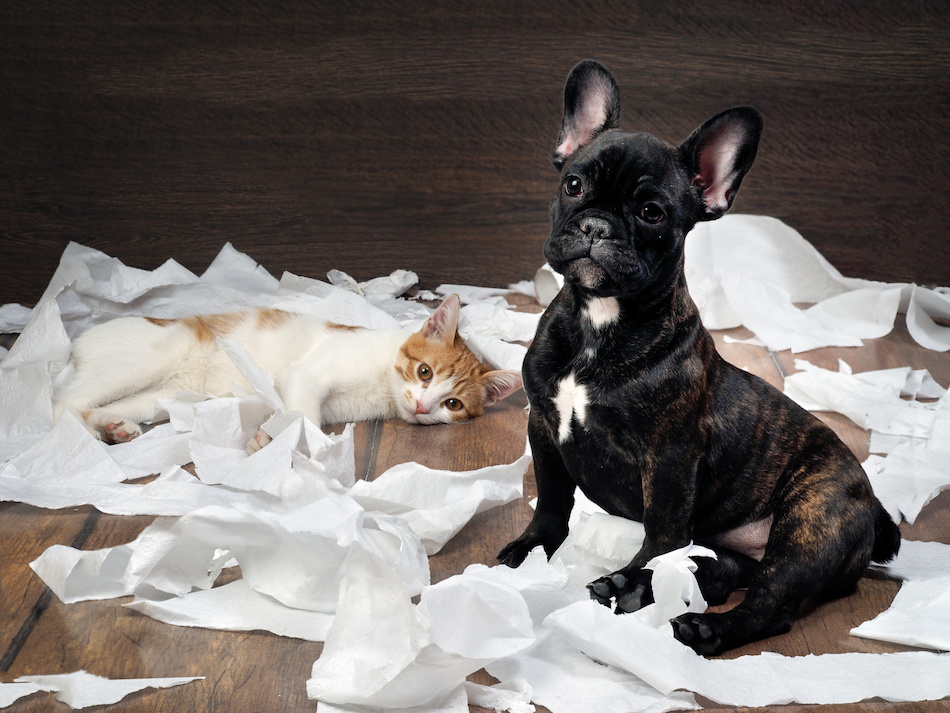
Some pet owners find it at least somewhat amusing that their pets try to drink from the toilet. Generally speaking, however, most pet experts agree this is not a good idea. A pet could slip and get trapped and potentially drown in a toilet. The toilet seat could accidentally come down on a pet trapping them or causing injury. There are also bacteria concerns that are present even in “clean” toilets.
Soaps and chemicals can cause issues as well. Many homeowners use in-tank cleaners to keep their toilets fresh. These bleaches, soaps, and chemicals can be harmful to pets. Even when bowls are cleaned without in-tank cleaners, access to pets should be restricted until the toilet has been flushed multiple times, assuring any cleaner residue is rinsed safely away.
A safer alternative to toilet water would be providing your pet with clean water daily in a clean bowl.
Showers and Bathtubs
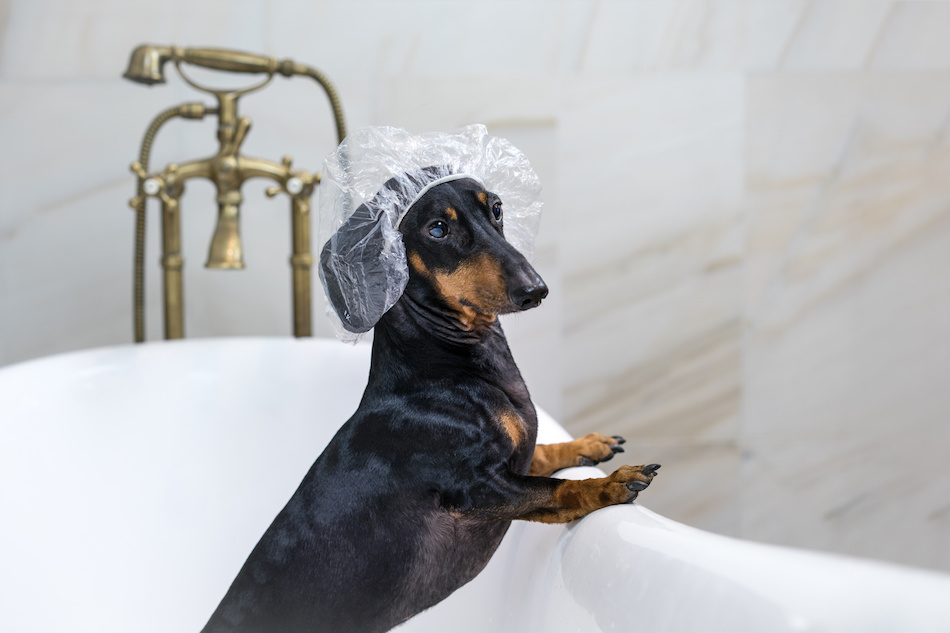
While showers and baths provide little safety risks as-is for pets, the same can’t be said for the products commonly found in them. Soaps, shampoos, and hair/body cleaners often contain chemicals like non-ionic and anionic detergents that can be harmful to pets. This is the reason that human soaps and shampoos shouldn’t be used on pets. Instead, it is safer to use specially formulated pet shampoo products.
Other products used in the shower like sponges and loofahs can be choking hazards when not kept safely out of the reach of pets. If there are products in the shower, keep shower doors closed. If that is not an option, restrict access to the area by keeping the bathroom door closed.
Pet Safety in the Kitchen
Food

It is easy to think that any food we enjoy, our pets will also enjoy. The reality is there are foods that can be dangerous, and even poisonous to our pets. Here is a list of food products that the ASPCA Poison Control Center lists as potentially harmful for pets.
- Alcohol – Any alcoholic beverage or food product can cause everything from vomiting and diarrhea in a pet to tremors, coma and death. You should never give alcohol to a pet.
- Chocolate and Coffee – Generally, the darker the coffee and chocolate, the more dangerous it is for pets. The methylxanthines in cacao seeds are the dangerous ingredient that can lead to panting, vomiting, excessive urination, and potentially death.
- Citrus – While a small amount of citrus fruit is generally considered harmless, citric acid in large amounts can be harmful to pets.
- Coconut, Coconut Oil, and Coconut Water – Like citrus, in small amounts coconut can cause little harm to pets. Coconut flesh and oils, however, can cause stomach issues in pets. High potassium coconut water should not be given to pets.
- Grapes and Raisins – While the exact compound is unknown, grapes and raisins have been linked to kidney issues in pets and thus should be avoided.
- Macadamia Nuts – When ingested by dogs, macadamia nuts can cause weakness, tremors, and vomiting.
- Milk and Dairy Products – Since pets do not have a significant amount of lactase, they can have a difficult time breaking down milk and dairy products resulting in diarrhea and other digestive issues.
- Nuts – Nuts that contain high amounts of fats and oils can cause vomiting and diarrhea in pets and should be avoided.
- Onions, Garlic, and Chives – These can cause stomach irritation and potentially red blood cell damage especially in cats.
- Salty Snacks – Salty snacks like potato chips, pretzels, and salted popcorn can cause excessive urination and thirst and result in tremors, fever, seizures, and in serious cases, death.
- Yeast Dough – Yeast dough that rises can cause a variety of stomach issues some of which can be very serious. Raw dough can also produce ethanol and essentially have alcoholic effects on a dog.
Other food products that can be dangerous to pets include raw meat, raw eggs, and bones that can splinter.
Trash
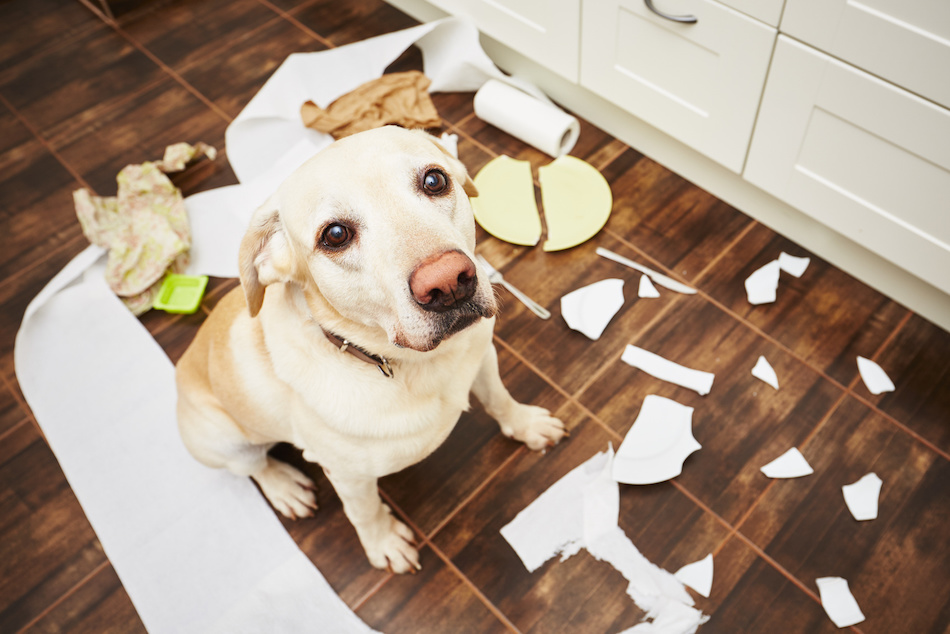
What pet owner hasn’t walked into the kitchen or come home from work to discover their furry friend has been exploring in their absence? Not only can trash contain food items that may be dangerous to pets, but old food may be bacteria-filled, causing severe stomach problems.
Trash also often contains plastics, bottle caps, twist ties, plastic bags, and other choking hazards. Sharp edges on trash cans and trash can lids can be problematic for pets. Trash may include broken glass, chemicals, soaps, and a myriad of materials that can create health issues. When a cat or dog goes rummaging through kitchen trash, it is not just an inconvenience — it can be very dangerous for them. A close eye should be kept on pets who have recently been exploring.
Keep trash more secure by investing in a heavier (but not top-heavy) trash can that may be more difficult to tip and that has a secure top. Many pet owners decide keeping trash under the kitchen sink and making sure it is not accessible to pets is the best solution. Many luxury homes already do this to some extent — keeping trash stored out of sight in an elegant fashion.
Pantry
If your home has a kitchen pantry, your pet probably knows about it and at least has an idea about the wealth of treasures within. They may not know exactly what the pantry contains but it will not stop them from trying to gain entry and finding out. If the pantry is used for storage of pet food and treats, it will pique your pet’s interest even more.
While some items kept in a pantry are relatively secure in cans, jars, and plastic storage containers, many items are in easy to open boxes and bags. These are the items that need to be kept up and out of the reach of pets. While many people tend to keep items like potatoes and onions on lower levels of the pantry, it can be more prudent to keep them higher, especially when kept in the original bags. Hanging these bags in a pantry may be an option.
The best solution for those with a pet and a pantry may be to keep the pantry door closed. Ideally, door handles should not be of the lever variety, as pets will have an easier time figuring these out if they’re rather clever.
Cabinets
It is critical that cabinets, especially lower cabinets containing chemicals and cleaning products be kept secure from pets. Pets can be surprisingly good at opening cabinet doors, leaving owners both impressed and frustrated.
Beyond dangerous home chemical and cleaning products, pets can get tangled in plastic wrap or get ahead stuck in stored plastic bags. Lower sink cabinets often contain trash cans. Smaller pets can get stuck in cabinets, have items fall on them, or knock items from the shelves of cabinets.
Check to make sure cabinet doors are closed completely after use. A door that is even slightly ajar can be manipulated by a prying paw. Spring-loaded hinges can provide more security, but often the simplest choice is childproof latches.
Nooks and Crannies
An often overlooked area in kitchen safety is the potential problems posed by the many nooks and crannies that can be found in some kitchens. Pets, especially small and young pets, have a natural curiosity to explore, and this can include areas between and behind major appliances, between appliances and cabinetry and even open dishwashers.
The best solution is to block any access to nooks and crannies. This can be done through an appropriately sized trash can or by sliding in a folding step stool or step ladder into smaller open areas. For those seeking a simpler solution, an expandable gate to totally block off kitchen access for your pet may be the answer.
Pet Safety in the Yard
Fences
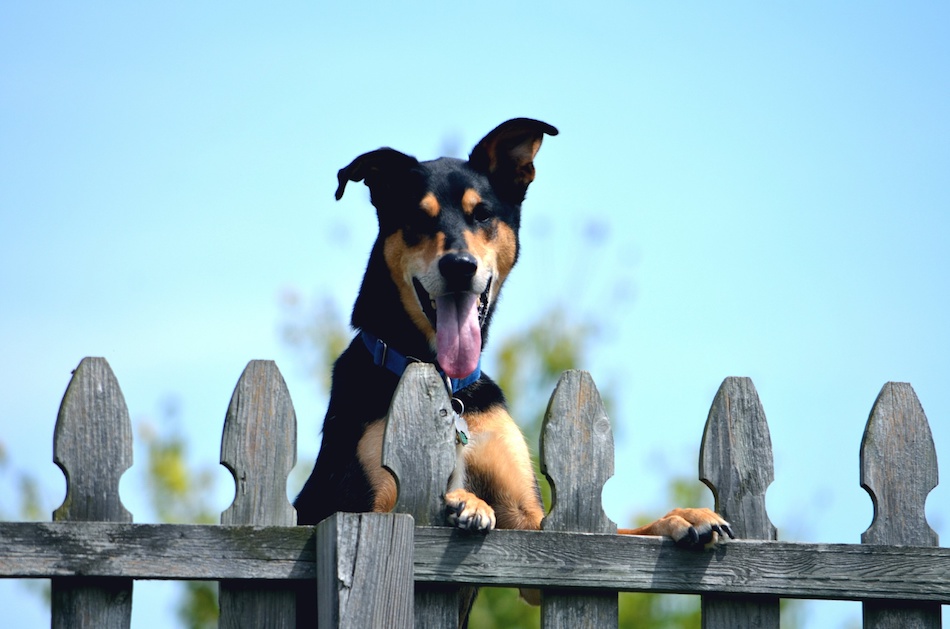
Fences are the first line of defence in keeping your pet inside your yard. That is, of course, unless you have a cat. Cats are natural climbers and the best you may be able to hope for is that a fence will contain a cat for a brief period.
For dogs, however, fences can be quite effective in keeping them out of harm’s way. Choosing the right fence will depend greatly on the size and jumping ability of a dog. For small dogs and puppies, a smaller chain link fence may work fine. For larger breeds or dogs who are good at jumping, a taller privacy fence may be necessary. For those in gated community homes, it’s better to not assume that the gates or fences around the community will be sufficient in the event your pet escapes the home.
While most owners will spend time focusing on the height of a fence, there are other considerations as well. Pet owners need to make sure that their pet won’t escape or get stuck between the vertical slats of a picket, iron or aluminium fence. Decorative or pointed tips of a fence can cause injury should a dog be unsuccessful in jumping the barrier. Finally, care should be taken to make sure a dog can’t dig under a fence and escape. There are several ways this can be prevented. A trench could be dug along the fence line before installation and cinder blocks placed in the ground. When a dog then tries to dig under the fence, they will be greeted with an impenetrable barrier. The fencing could also partially extend below the surface to discourage digging.
Toxic Outdoor Plants

A pet that is allowed outdoors will eventually find, and perhaps even chew on, plants that may be harmful to them. Plants affect dogs and cats differently. If any of these reside in your garden, consider removing and replacing them with non-toxic flora.
Outdoor plants harmful to cats include:
- Amaryllis
- Autumn Crocus
- English Ivy
- Lillies
- Narcissus Bulbs
- Sago Palm
- Spanish Thyme
- Tulip Bulbs
Reactions can include everything from mouth and skin inflammation to more serious issues to the heart and kidneys. Symptoms may include trouble breathing or swallowing excessive urination drooling, excessive thirst and an irregular heartbeat.
Outdoor plants that can be problematic for dogs include:
- Bleeding Heart
- Castor Oil
- Foxglove
- Hemlock
- English Ivy
- Jimsonweed
- Lilly-of-the-Valley
- Mistletoe
- Oleander
- Peace Lily
- Rhubarb
- Thorn Apple
- Unidentifiable Mushrooms
If dogs demonstrate any unusual behaviour or listlessness after being outdoors, owners should contact their veterinarian.
Pools
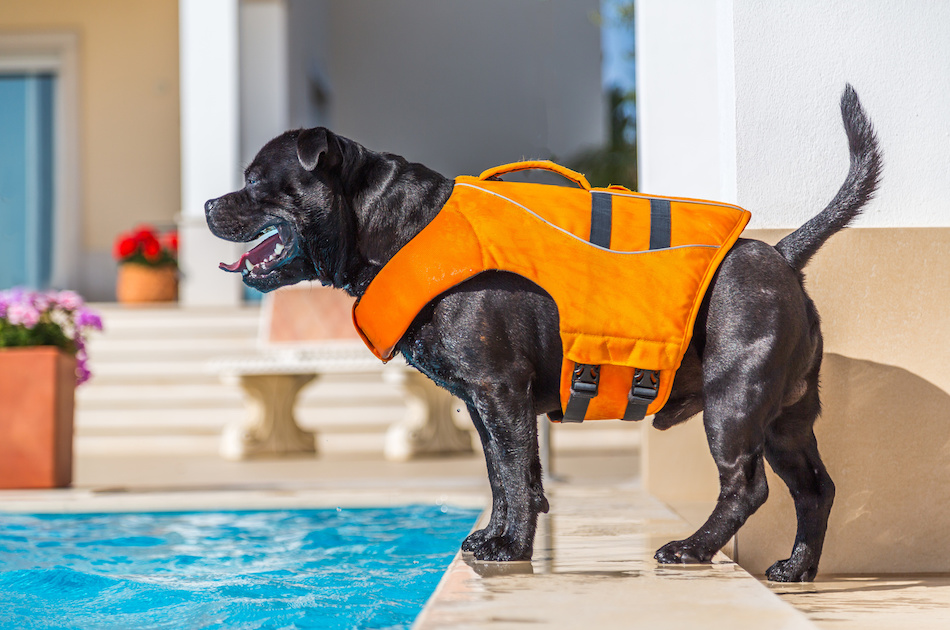
While we tend to believe that all dogs are good swimmers and have an inherent ability to “doggie-paddle”, dogs can and do drown. A dog’s ability to swim is often based on the breed of the dog. Dogs that have large chests have a greater ability to stay afloat and swim, with leaner breeds with shorter legs having a disadvantage in the water. Obese and geriatric dogs are also at a higher risk of drowning.
The problem is that dogs have a tendency to only use their front legs when paddling. This can ultimately place them in an almost vertical position in the water. After a time, they can become exhausted and the potential for drowning increases.
Many dogs can benefit from simple swimming lessons given by their owners. Owners can spend time in a pool with their dog, lifting their hindquarter to encourage the use of rear legs. There are also life preservers for pets that can assist dogs in staying afloat.
Owners can make pools safer by showing pets where the safe entrances and exits are to enter or leave the pool. These can be reinforced with visual clues like potted plants or an umbrella table in the area of the safe exit. Additionally, if you live in a golf course home or an oceanview home near the water, you’ll want to make sure your gate or fences do not have gaps or holes near them that would let your dog escape unattended.
Beyond drowning, pets can be exposed to a variety of other pool-related safety issues.
- Heatstroke – Dogs are susceptible to heat stroke just like humans. Take precautions if a dog begins panting excessively or is otherwise acting oddly in the heat.
- Proper Hydration – Make sure your pet has a good supply of cold, clean water available outside. If not, a dog might be tempted to drink excessive amounts of chlorinated water from the pool.
- Paw Care – Concrete surfaces surrounding a pool can be rough. A few hours of excited jumping in and out of a pool can cause scuffing to paws and even cause bleeding or worn down nails.
- Avoid Floating Pool Covers – A dog, or child for that matter, can get trapped under a floating pool cover. As such, these are not recommended for households with either in their care.
- Fencing – Many pool fences are designed to protect children from getting into the pool area. Make sure pool fencing can also keep your particular pet safe as well. If a pet can jump over the fencing, they may not have a way to get to dry land once they are on the other side.
- Consider Floating Alarms – There are alarms available that will sound when a wake is created in the pool. This can alert pet owners that a pet has entered the pool.
Taking proper precautions in protecting pets from harm around pools will keep a pet safe and give owners peace of mind.
Standing Water
Standing water can be a tempting play area for pets and may even provide a source of water for a thirsty animal. There are dangers to standing water, however, and it should be removed from your yard to keep pets safe. Standing water can also attract animals and serve as a breeding ground for mosquitoes and other insects.
- Canine Leptospirosis – This is a dangerous bacteria that can contaminate standing water if it has been urinated in by an infected rat, deer, cow or variety of other animals. Not all dogs have an adverse reaction to drinking contaminated water but for those that do, reactions can be severe. There is a vaccine available that may help and your vet should be consulted to see if it may be a problem in your area.
- Giardia – This is a microscopic protozoan that can live in standing water contaminated by animal feces. Symptoms include diarrhea and/or vomiting. Your vet can determine the presence of Giardia and it can be treated with medication.
- Pythiosis – Known as “Swamp Cancer” this is a rare condition that is more prevalent in standing water in Gulf Coast states. Pythiosis attaches itself to small wounds on the skin or in the digestive tract and can quickly grow. It often is treated with surgery.
If you have standing groundwater in a yard, there may be drainage issues that need to be addressed. Check for standing water in other items like buckets, pails, birdbaths or any item that may collect water as well.
Trash Bins
Outside trash bins often contain an assortment of items that can be choking hazards for pets. These items can include bones, plastic or metal bottle caps, plastic bags and wrappers and more. Food scraps and waste can provide a bacterial health danger to pets if ingested.
Outside trash bins should have lids that close firmly and should never be so full that tops cannot be firmly secured. If a pet has been successful at getting into an outdoor trash bin, owners should try to determine what items may have been chewed on and keep a close eye on your pet for any unusual behaviour like vomiting, diarrhoea or choking. If a pet appears lethargic following an adventure in a trash bin, owners should contact their vet to further investigate any potential problems.
Fire Pits
Outdoor fire pits are more popular than ever. They can serve as a centrepiece to a quiet evening outdoors or as a gathering place for cool nighttime parties. Of course, many pets will want to join in on the activity surrounding a fire pit. There are steps owners should take to keep a pet safer around fire pits.
- Keep the fire pit contained and under control – A fire pit should be just that, a designated area for a smaller fire. The size of the fire should not exceed the design of the pit. Take steps to keep control of the fire with water, sand or an extinguisher nearby.
- Set boundaries for your pet – Pets should be trained not to get near the fire pit or be restrained on a leash to prevent him from getting too close.
- Don’t leave pets unattended – Pets should never be left unattended while a fire pit is burning. Burning wood can crackle and cause hot embers to spark out and away from the pit. Pits that are, or have been used for cooking meats can be particularly attractive.
- When done, extinguish the fire completely – A fire pit that is left burning can remain hot for 24 hours following use. Fires should be extinguished with water, stirring the ashes to make sure they are all getting doused. Do not allow a pet near the fire pit for a while after use to prevent accidental burns.
Don’t assume your pet knows that flames are hot or dangerous. Take precautions to keep your pet safe while enjoying the outdoors.
Pet Safety in the Garage
Tools
Garages are full of various tools that range from ladders to power saws to hedge clippers. Long-handled tools and ladders that are stored leaning against a wall can be easily knocked over by a pet. They can more safely be stored on hangers designed to hold them in place.
Power tools should always be unplugged to prevent electrical shock to a cord-chewing pet and safely stored so they won’t fall or be pulled down on a pet. Small nuts, screws, and bolts can present choking hazards and should be stored in containers or drawers.
Pet owners should pay particular attention to sharp objects like trimmers, hand saws, blades and others. Keep in mind, cats like to climb, so keeping workbenches and shelves clear can improve safety. Shelving safety can be enhanced by attaching units securely to the wall.
Chemicals
Garages often contain more chemicals, solvents, and fuels than any other area of the home. This is one of the reasons it can be an unsafe area for pets. There are some simple steps you can take to improve the safety of your garage.
- Keep chemicals and fluids in original containers.
- Keep lids tightly closed on containers.
- Keep containers stored in cabinets with the doors closed.
- Never place open bottles or cans with liquids on a workbench
One of the most dangerous liquids for dogs in a garage is antifreeze. Only recently has antifreeze been made less appealing to dogs by reducing its sweet flavour. What makes antifreeze so dangerous to dogs is that it contains ethylene glycol, which even in small amounts will cause diarrhoea, vomiting, and weakness. Ingesting antifreeze can lead to kidney failure, seizures, and a coma. Even after extensive therapy, many dogs do not survive antifreeze toxicity.
Other garaged chemicals that can be toxic to pets include gasoline, motor oils, cleaners, and car waxes. Garages also contain other non-automotive related products and chemicals like pesticides, paints, paint thinners, yard chemicals and more.
Typically, the best solution for pet owners is to keep the garage off-limits to their pets if hazards like these are present.
Cars
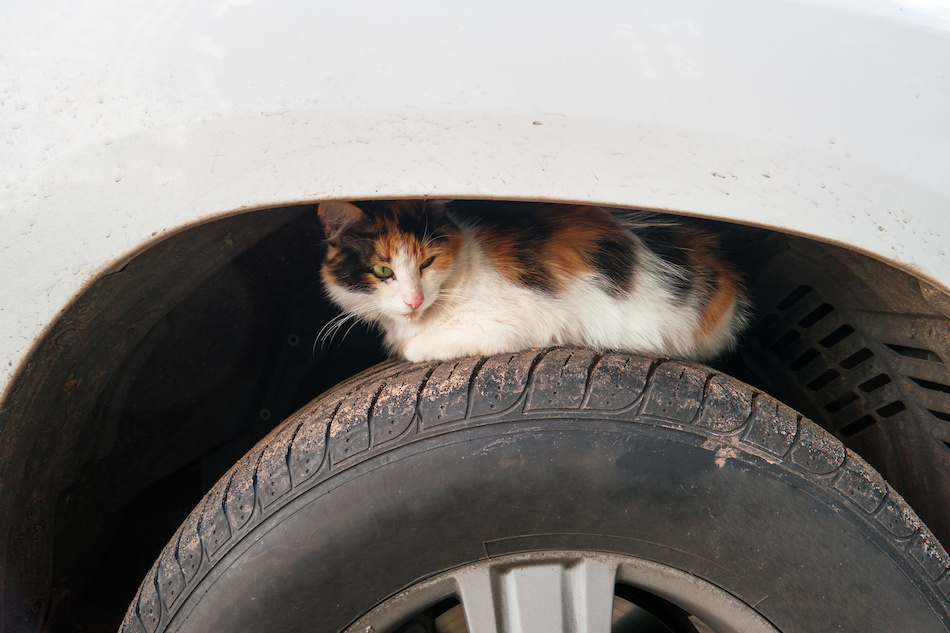
Cars parked in a garage pose some specific problems for pets. Cats, for example, may find the warm engine from a recently running car comfortable, especially in cool or cold weather. You can help keep cats safer by checking an engine compartment before starting a car or by banging on the hood to scare any cat out from the area.
Cats may also snuggle against the tires of a parked car or climb in through an open window. Carbon monoxide from a running car can be dangerous or fatal to both pets and humans, so avoid keeping cars running in enclosed spaces.
If a pet slips into a garage unknown overnight, they may quickly escape when the door is opened in the morning.
Know where your pet is every night before retiring and be sure to check the garage. Keeping garage doors shut and limiting access can go a long way in keeping your pet safer.
Heavy Objects
Your garage likely contains a number of heavy items that cause harm to a pet should they fall or a pet becomes entangled with them. These include:
- Heavy power tools
- Cans and containers
- Hanging tools
- Long handled yard tools like rakes and shovels
- Ladders and step stools
- Bicycles
- Outdoor grills
- Shelving units
Care should be taken to make sure these heavy items do not pose a risk of falling or tipping onto a pet. Shelving and shelving units should be stable enough to support a climbing pet without tipping or falling. While small dogs may not be able to create much havoc in a garage, climbing cats and large dogs can be problematic. Taking a quick inventory and securing larger heavier items can help protect your pet and keep them safer from harm.
Boxes and Storage
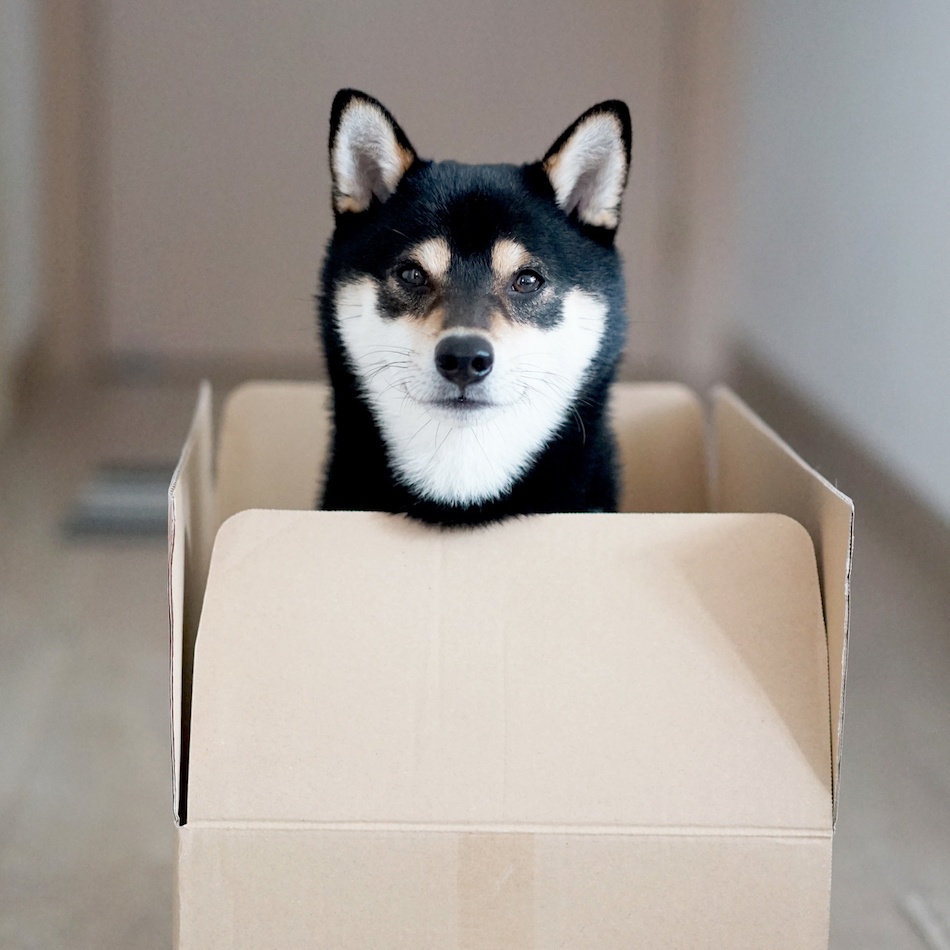
Many households use garages for additional storage. Boxed items can create several risks for pets.
- Stacked boxes can be a tipping hazard
- Cardboard boxes can be chewed on and potentially accessed by pets
- Pets may accidentally get trapped in an open box
- Pets may gain access to choking hazards or dangerous products contained in cardboard boxes
Boxes may contain stored holiday items like light strings, fragile glass bulbs, tinsel, and garland that can cause health or choking issues for pets if ingested. Stored items may be boxed using plastic bags, rubber bands, paper clips or other items dangerous to animals.
Pet owners can make stored items in the garage safer by using plastic bins that can stack safely and that close securely as opposed to cardboard boxes.
Pet Safety in the Laundry Room
Detergents and Bleach
Whether a home has a specific laundry room or a laundry area, it can present some safety hazards to pets.
Detergents and bleaches are significant issues that can be minimized by making sure caps are firmly reattached after use. Keep in mind that if something other than a cap is used for measuring a product, that container may have residue of the cleaning product. This should be kept out of the reach of pets and thoroughly rinsed.
Fabric softener dryer sheets contain chemicals that can be harmful to pets and can be a choking hazard when torn. All laundry related chemicals, including dryer sheets, should be safely stored in a cabinet with the door closed.
Washer and Dryer Safety
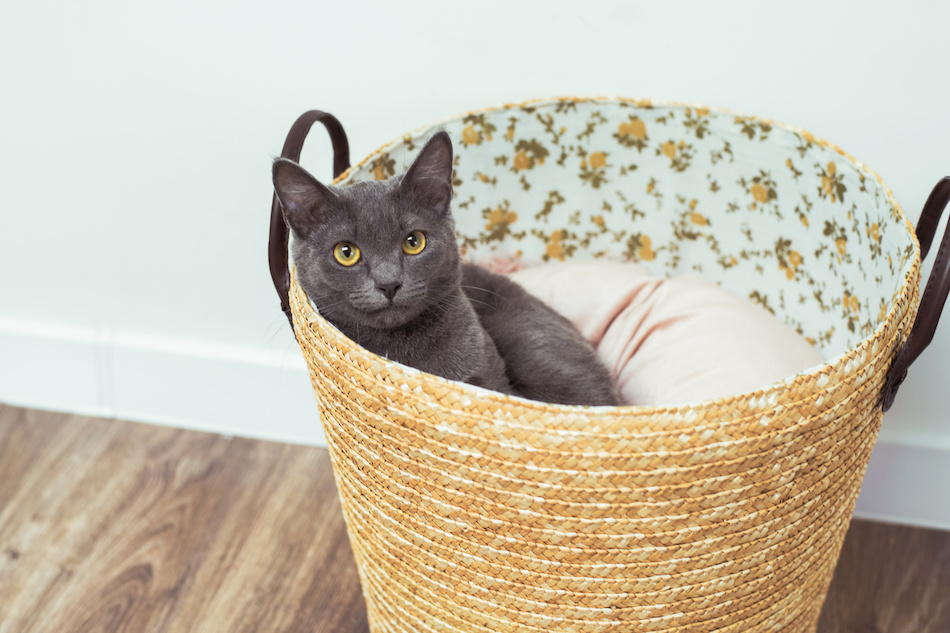
Beyond the products used in a laundry area, the equipment itself can pose safety risks to pets. An open washer may prove too tempting for a small cat. An open dryer door may be inviting for pets seeking a warm place to sleep or hide. Check washers and dryers before use and keep doors closed to prevent trapping curious pets.
Clothes left in a laundry basket near washers and dryers may become a playground for young pets with buttons posing a potential choking hazard. Care should be taken to minimize this risk.
Nooks and Crannies
Laundry areas have a number of nooks and crannies where pets — especially small ones — can get into trouble. Because of vents and hoses, washers and dryers cannot be placed up against the wall behind them leaving an area small pets may want to explore. Laundry areas may include ironing boards hanging racks for clothes, storage areas, and shelves. This combination can create an almost endless source of areas to explore.
If it is not possible to secure your laundry area by closing a door, seek to find barriers to these nooks and crannies to prevent a small pet from becoming trapped.
Irons/Ironing Boards
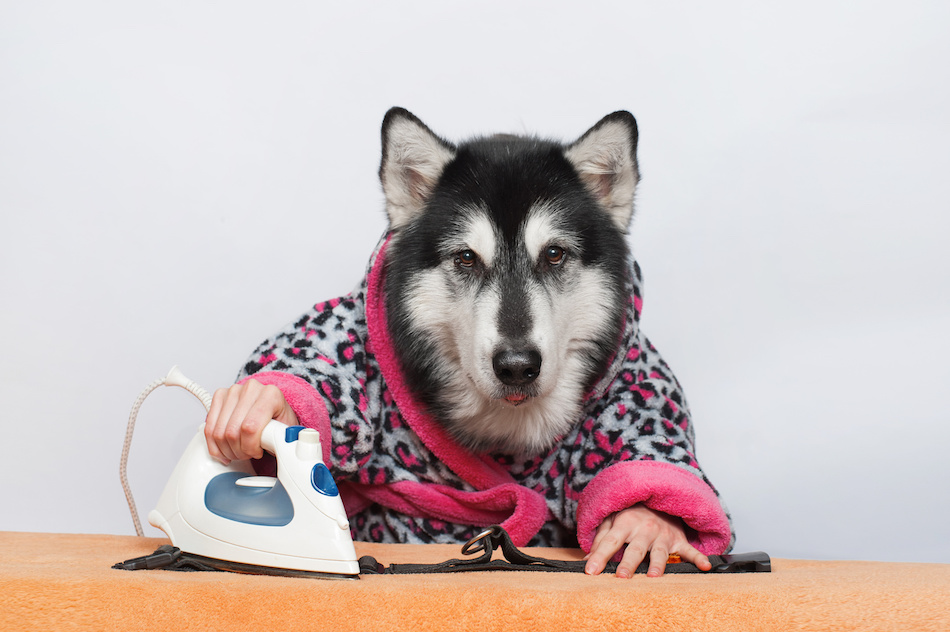
Irons and ironing boards present a variety of safety issues for pets depending partly on how they are used and stored. Ironing boards are somewhat unstable whether they are leaning against a wall or even when properly set up. Add a several pound iron with a cord dangling down and you have a potentially dangerous situation for pets.
Ironing boards should be set up and irons plugged in only when they are being used. Don’t allow dangling cords to be a temptation for pets. Store ironing boards where they won’t fall on pets like in a closet or between a wall and refrigerator. Store irons securely away where pets won’t chew or tug on electrical cords. Avoid hanging ironed clothes from the edge of an ironing board as they too, may serve as a jumping temptation for pets.
Irons and ironing boards may be an afterthought when not in use, but they shouldn’t pose a safety risk to a pet when stowed away. Taking a few precautions can better protect your pet.
Pet Safety in the Living Room
Furniture
Pets and their owners often spend a significant amount of time in the living room. Furniture will play a big role in the enjoyment of this space, but it should be chosen with safety in mind.
Taller items like curio cabinets or bookcases should not be top-heavy, and if there’s any chance a climbing pet could topple it, steps should be taken to secure the top portion to the wall.
Large pets will appreciate larger moving spaces that will keep items on tables from being knocked over when playing. Surfaces of end and coffee tables should be scanned to make sure any item that is prized or easily toppled is placed in a safer place.
TVs
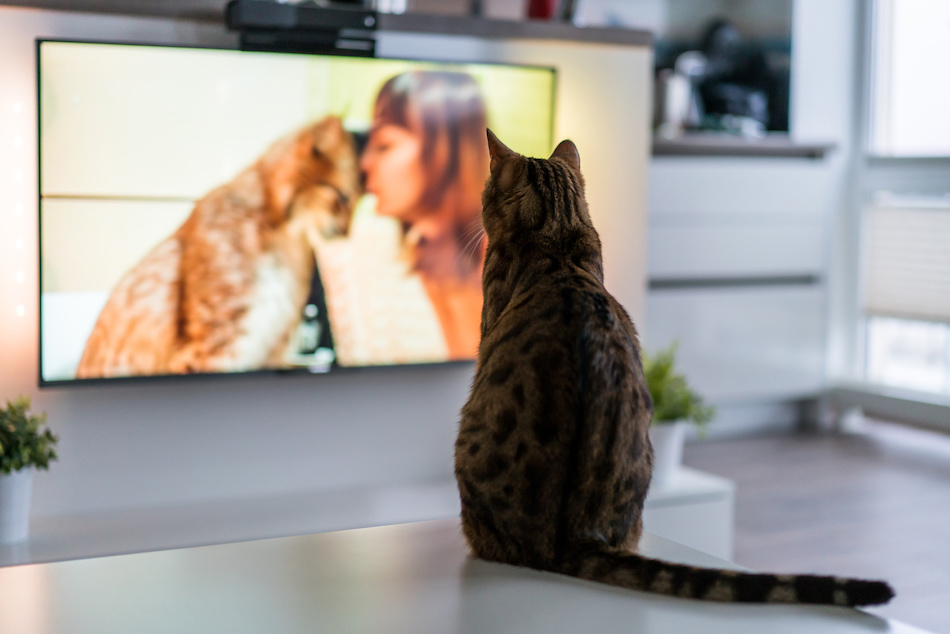
Today’s flat-screen TVs can create some specific problems in homes with pets, especially medium to large size pets who may have the mass and capacity to topple table-mounted screens. While the feet on these larger flat screens are sufficient to keep screens safe in most circumstances, an excited or playful larger pet could create a problem when bumping into it. Many pet owners prefer wall mounting their flat screens TVs to resolve this issue. Mount televisions high enough so pets can’t reach up and scratch the screen or otherwise damage the unit and secure cords so they cannot be pulled or chewed on.
Another aspect to consider in a living room is the presence of remote controls. Remotes can be chewed into small parts that can harm a pet — batteries can cause issues as well. Owners can make a living room safer by storing remotes in a drawer.
Heavy Decorations and Objects
Heavy decorative and other objects pose a safety risk to even larger pets in living room areas where pets and owners often play and spend quality time. These can range from taller cabinets and bookcases to free-standing lamps, plants, decorative pillars, and artwork.
One of the best ways to keep the living room safer for pets is to be better aware of the “steps” that cats will use to achieve a high position in the room. If furniture and decorative items allow a cat to elevate their position from one piece to another, they will attempt to. Owners can avoid this by positioning items where they can’t be reached from one another.
Wall-mounted shelves filled with decorative items or photos can be tempting for cats as well. Make sure shelves are soundly attached to walls and don’t provide a “ladder” where a cat can show off its climbing prowess.
Keep in mind that seasonal decorative items like Christmas trees can also pose a safety threat to animals from both falling and choking hazards.
Candles/Potpourri
Pets should never be left unattended where flames from a candle or potpourri holder are burning. Candles can be upended causing burns or a fire. Hot water from a potpourri pot can also cause burns when spilt by an exploring pet.
Much safer alternatives include electric candles or a potpourri or scented wax heater that creates scents without an open flame. Keep cords for these heaters safely out of reach of pets, however. Cords may be chewed on causing an electrical shock hazard or be tugged upon, spilling the hot contents. Even these electric options should never be left on while pets are unattended.
Some dried potpourri, candles, and other types of air fresheners may contain ingredients that also may be toxic to cats. Be sure to follow label directions.
Make Windows Safe for Pets
Keeping Them Closed
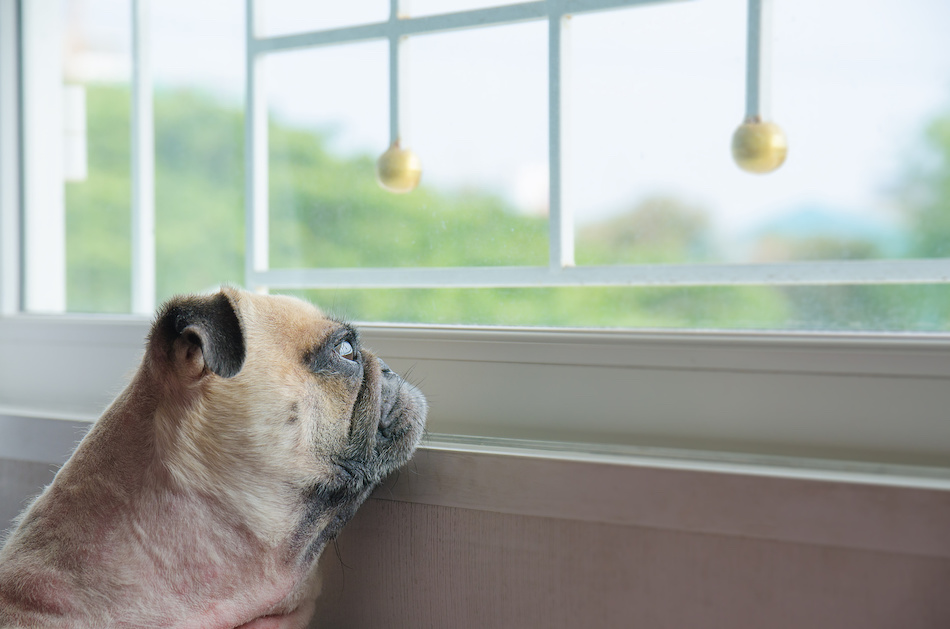
Leaving a window open while you are away is almost never a good idea. An open window can cause a problem if it rains; it may be an invitation to a burglar and may serve as an escape route for pets. Apartments or Los Angeles condos in a high-rise have the additional danger of a pet running or falling through a screen and falling multiple floors to injury or worse.
There are several options to an open window to give pets a view in your absence. Some choose to create a padded platform to be placed near the interior of the window. Cats may appreciate a carpeted cat tree near the window. If homeowners feel they must crack a window for ventilation, they should see if they can open it from the top down for several inches. This will prevent pets from breaking through an open lower window while limiting the intrusion of any rain.
Even when pet owners are home, care should be taken to prevent animals from falling through a screened window. There are a variety of pet and child safety products available that can be installed in an open window in a home or apartment.
Safe Screens
An open window with a screen is sure to serve as a perch for cats to look out upon their kingdom. A passing bird or squirrel could cause excitement, however, and a pet may end up bursting or falling through a screened window. The older the home and window, the more likely this is to occur.
Owners can help pet-proof screens by replacing standard screens with those made of fibreglass, but it is important fibreglass screening material is put in properly. It may be a good idea to have them professionally installed.
Another option to weak screens is metal window guards. While strong, they can limit airflow and might not be aesthetically pleasing. They are still a safer alternative to screens and should also be professionally installed.
Blinds/Cord Safety
Pet owners with blinds and curtains on their windows should take extra precautions in making sure cords don’t present a tangling or choking problem. These cords may attract the attention of pets as they dangle in a breeze or move as the pet brushes by. A cat or dog may find itself pawing at or chewing on the cords and tassels and can get itself in a tough position quickly, especially when no one is home.
Window covering products made prior to 2001 can be especially hazardous. If you have a pet and have these products in your home, seriously consider replacing them with more modern, safer options. These include cord-free choices for drapes and blinds.
Furniture should be placed away from any corded window coverings. Any cords should be short and attached to the wall or window sill. Open blinds should be locked into position by securing them in place.
Most don’t give window covering cords a second thought. Becoming aware of their existence and potential hazards to pets can go a long way in making your home more pet safe.
Safety Around Electronics
Bedrooms

Bedrooms are one of the most popular rooms in the home to recharge electronic devices. Care should be taken to keep cords from being too easily accessible, especially for kittens and puppies. These chargers can be tempting to play with and pull and chew on. This, of course, can lead to a variety of issues.
Keep in mind that charger cords, when plugged into a wall socket, can still cause a shock when not plugged into a device. Cords may not only cause shocks but can become choking hazards when the plastic is chewed on or an end is chewed off.
Bathroom
Curling irons and hair straighteners can reach temperatures in excess of 400 degrees. This is an obvious risk to pets when in use, but even when not in use, appliances in the bathroom can still pose dangers. The cords of electric razors and hair dryers can be tempting to chew on and potentially cause a shock to a pet. Hanging cords may be tugged upon, pulling both the appliance and nearby products to the ground where there are even more accessible to dogs or cats. Luckily, many new construction homes are now built with better cord and electronics organization in mind, so there may already be areas for cords to reside without being exposed to curious pets.
You can create a safer environment for pets by winding up cords properly when they are not in use and storing them safely out of sight and reach of your four-legged friends.
An additional step you can take to better ensure you and your pet’s safety when using electrical appliances in the bathroom is making sure any sockets near water are GFCI (ground-fault electrical interrupter) sockets that can prevent shocks should a short occur.
Kitchen
Modern conveniences mean more safety issues for pets in a kitchen. Generally speaking, major appliance cords are safely tucked behind the appliance. The issue is often smaller, countertop appliances that can provide pet safety problems.
Oftentimes, the biggest issues are cords that are exposed and may be tempting to play with, pull or chew on. Unplugging these appliances can remove the shocking hazard from chewing on a cord, however, chewed insulation and plastic can still cause choking hazards. Large dogs may easily have the ability to pull on a small appliance cord, toppling it from the countertop. Moving these smaller appliances further back on countertops or storing them when not in use is advised.
Living Room
A living room may have more cords than many imagine. There are electric cords for televisions, lamps, sound equipment, and perhaps external speakers. There are cords for electronic devices and chargers. All of these cords can harbour a danger to pets.
Cats, in particular, enjoy playing with and chewing on cords. This can cause a shock hazard and potentially an electrical fire. If a larger animal decides to pull on a cord, the pet can hurt itself with a falling object. Keep in mind that charger cords can create a shock even when a device is not being charged. Most chargers also have much thinner protective coverings that can allow them to be pierced by a pet’s teeth easier.
There are a variety of cord management devices that can help keep cords neat and protected from pets. Channels, conduit, and tubing can run cords along and attach to baseboards, streamlining their appearance and limiting their temptation to pets.
Safety Around Small Objects
Sharp Objects
Bathrooms can have a variety of sharp items that pose safety risks to pets including razors, razor blades, tweezers, nail files, scissors, and more. These items can cause harm to curious pets and be potentially deadly if swallowed. Caution should also be taken when storing small mirrors that could be knocked off a countertop or sink and broken into sharp pieces.
Jewelry and Other Choking Hazards
While jewellery is attractive to humans for a variety of reasons, they can also be appealing to pets. Thin chains and necklaces can appear to be toys for a young pet and coloured earrings and beads and other jewellery can be easily mistaken as a treat or an item worth chewing on. Jewellery and numerous other small items in a bedroom can create an abundance of choking hazards for pets and should be stored safely away.
Helpful Resources for Pet Home Safety
To learn more about creating a pet-safe home, we invite you to use the following resources:
- ASPCA Animal Poison Control Center Phone Number: (888) 426-4435
- Find out about everything dog-related from the American Kennel Club (AKC)
- Information on Cat-Proofing a home from Animal Planet
- ASPCA list of toxic and non-toxic plants for pets
- Plants that may poison pets from the Human Society of the United States
- Keeping pets safe from hazards in the garage from the Pet Health Network
- 40 Best and Safest Pet Fences from Safety.com
- Custom Natural River Stone Pet Memorials apetmemorial.com
* This blog is designed to be a community where pet owners can learn and share. The views expressed in each post are the opinion of the author and not necessarily endorsed by Pawjourr. Always consult your veterinarian for professional advice.
